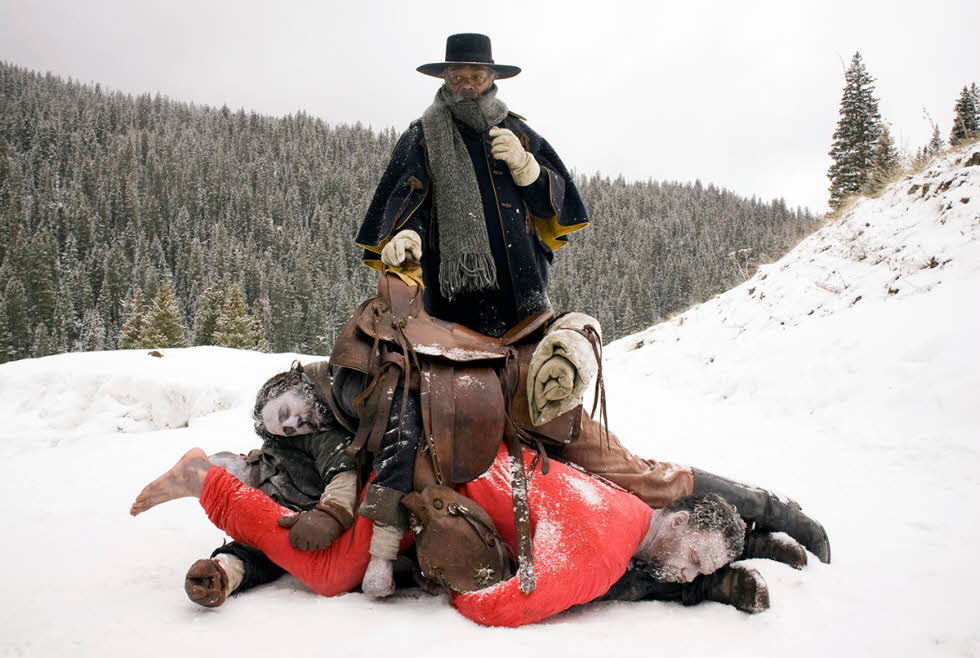When you walk into a Quentin Tarantino film, you can expect three things: Lots of blood, an intricately layered storyline, and Samuel L. Jackson. If you’ve seen The Hateful Eight, you’ll recognize that Tarantino meets those expectations, and then quickly surpasses them. Granted, this movie is not for everyone. It is long, drawn out, and gory; however, if you have the patience and the stamina, it is well worth the watch.
The first chapter the movie takes place inside of a horse-drawn wagon, ushering bounty hunter John Ruth (Kurt Russell) and his prisoner Daisy Domergue (Jennifer Jason Leigh) off to the town of Red Rock so she can be hanged. On the way, they reluctantly pick up Major Marquis Warren (Jackson) and Sheriff Chris Mannix (Walton Goggins). This ensemble of three law-enforcers and a criminal makes for a violently slapstick wagon ride until they reach their checkpoint, Minnie’s Haberdashery, where they’re forced to hole up in the face of an impending blizzard. It is here that the story picks up, and we leave the beautifully shot, snow-covered Wyoming wasteland, and enter the cabin that houses the rest of the cast, and serves as the setting for the rest of the movie.
In Minnie’s Haberdashery, the audience is introduced to familiar actors such as Bruce Dern, Michael Madson, Tim Roth, Demián Bichir, and Channing Tatum. For the remainder of the movie, you get the sense that you are watching a vengeful spaghetti western that has crossed over into Jean-Paul Sartre’s No Exit. Everyone is trapped in one room facing existential dilemmas and playing a game of “whodunit?”
Audience engagement is a major component of this specific movie-going experience. Assumptions are made and suspicions rise. Once a culprit seems apparent, suspicions are then disproven with the introduction of a brand new concept or character and it’s back to square one. This technique is how Tarantino keeps audiences on the edge of their seat for the entirety of the film.
If you're unable to see the film in its 70mm glory, the standard 35mm format is still very much worth the watch. The bleak, snow-covered setting in conjunction with the cinematography and panning shots of landscape serve as vehicles of isolation that allow audience members to join the cast in that horse-drawn wagon, and feel the familiar yet fraught dynamic between every character.
Ennio Morricone’s score is so subtly catchy that during the screening, you are almost unaware that there is even music in the background at all; however you will leave the theatre humming the theme that you realize was playing the entire time. The music aids in the suspense and anxiety of the characters for the duration. From the beginning, even before any important events occur, the music gives an ominous impression of the conflict that will inevitably play out over the next two hours. Inspiration for the soundtrack was taken from the screenplay itself, and was further influenced by the Italian Giallo genre, a slasher/thriller genre equipped with elements of mystery, crime or the supernatural.
Overall, The Hateful Eight combines elements of drama, comedy, western, action, romance, and thriller. As Tarantino does so well, the movie was exciting and unpredictable, gruesome yet tasteful, and generally just fun to watch. Even if you are of the faint of heart, the tongue-in-cheek dialogue alone makes up for the generous amount of violence and fake blood. The best advice would be to know when to close your eyes, sit back, and let Mr. Tarantino lead you into his twisted cinematic world.









